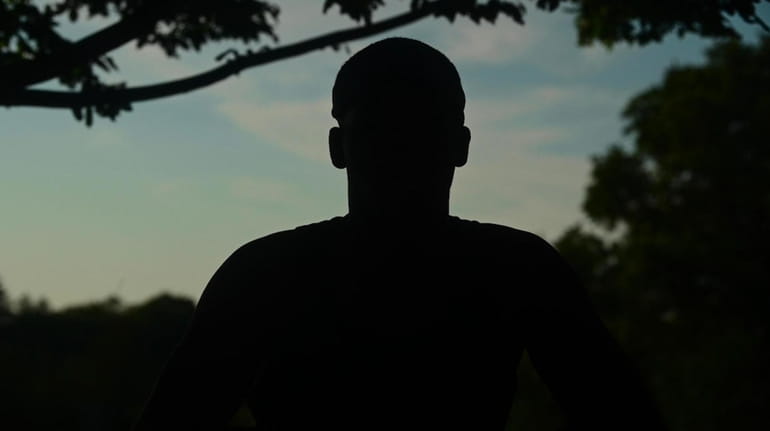'Get out': LGBTQ youth at disproportionate risk of homelessness during COVID

The dad in central Nassau had been rummaging through his transgender 22-year-old’s bedroom during the coronavirus pandemic’s peak and found a doctor’s instructions for taking testosterone.
There was yelling.
“Get out,” the dad said to A.
“Fine.”
Within hours, A. was homeless, subsisting on canned food and living an hour away, somewhere on Long Island in the woods.
“They didn’t want me to transition, and they would never accept me as their son,” said A., who provided this account and spoke on the condition that only a first initial be published, for fear of further alienating the family.
LGBTQ youth on the Island, some cooped up in hostile homes for months during the pandemic and lockdown, have been at disproportionate risk of being kicked out and potentially becoming homeless, part of a national trend, according to those who work with the population.
“With COVID, these clients, these people, they’re forced to stay in the household more than they did previously. So there is a higher risk of, maybe their parents coming across something, or overhearing a conversation,” said Devon Zappasodi, Suffolk project director for Pride for Youth, which is based in Deer Park and Bellmore and provides services, including to these young people.
“Places that these folks would go to for their outlet that was supportive” — schools, work, social organizations — became suddenly unavailable, Zappasodi said.
Some of these youth end up in homeless shelters. Some couch-surf at friends’ homes or camp outdoors. Some are on the street.
Transgender youth can also face a dilemma if considering a homeless shelter, some of which foster traditional notions of gender, advocates for the population say.
The U.S. Department of Housing and Urban Development under President Donald Trump is considering a policy that would essentially rescind a 2016 Obama-era policy and base shelter admissions “on biological sex, sex as identified on official government identification, or the current rule’s mandate of self-identified gender identity,” according to a July 1 news release. Local government policies, including those for New York, could override this change.
The transgender population overall is 0.3%; those who identify as lesbian, bisexual or gay are 3.5% of the population, according to the Williams Institute at the UCLA School of Law.
According to an April report by the institute, between 20% and 45% of homeless youth identify as LGBTQ. And among people between the ages of 18 and 25, people who are LGBTQ have a 2.2 times greater risk of homelessness than those who don’t so identify, the report found.
Zappasodi said that during the peak of the pandemic, Pride for Youth went from one or so youth-homelessness clients a month to four or five — though the number has begun to level off as the state reopens. But the population remains at disproportionate risk still, as before the pandemic.
Christine Geed, a spokeswoman for Nassau County, said that in 2019, 30 out of 163 housed youths identified as LGBTQ, and this year six out of 50 did.
Jason Beck, a spokesman for Suffolk County, said he spoke with its Department of Social Services commissioner, Frances Pierre, who said that the county hasn’t seen an increase in homelessness among the LGBTQ population, but that the county does not maintain data on the group, Beck said.
Mike Giuffrida of the Long Island Coalition for the Homeless said screening to identify the population involves “difficult questions for a program staff to ask someone, let alone at program intake or first encounter.”
No entity tracks the population’s size on the Island, and New York City can offer a richer array of resources, Zappasodi said.
“New York City has a lot more LGBTQ-specific housing,” said Zappasodi, who has had clients seek services in the city instead of the Island.
Asked in mid-July about this population, Mayor Bill de Blasio said at a news conference that “it’s been a really tough time,” that the city has been expanding shelter capacity for years, and “what we’ve found is, the more we make opportunity available to protect people, that folks come in off the streets and, and take that help.”
“A lot of them, kicked out of their homes by their own families, which I — it just disgusts me that that would ever happen, but it does,” de Blasio said.
One of the resources in the city is the Ali Forney Center, a homelessness-services provider that is based in Harlem and aims to help young people “overcome the harms of family rejection.” The center last year served 2,000 young people from across the country, including six from Long Island, said executive director Alex Roque. It has four Long Islanders out of 963 so far this year, Roque said.
Another resource from which the population seeks help is Callen-Lorde, an organization based in Chelsea that provides therapy, medical care, hormones and referrals for surgery. Although most come from within the city, their client base draws from the local suburbs and beyond.
“We do have patients coming from Long Island, coming from Westchester, or even a little bit further north,” said Dr. Uri Belkind, a pediatrician and the group’s associate medical director for adolescent medicine, adding: “There are patients that just want to receive care somewhere, that don’t want to be seen in their communities going to the quote-unquote LGBT health center.”
David Kilmnick, president of the Hauppauge-based LGBT Network, said 43 young people between 12 and 18, who were either runaways or homeless, reached out to his organization by phone, email or Facebook between January and July of this year, compared to 36 for the same period in 2019. Of the 43 this year, 32 were since April.
“We need to come up with a solution to keep these kids on Long Island and not ship them off to NYC while we work on changing communities and helping families.”
Among those who remain living with family, there can be pressure to suppress self-expression for fear of being told to leave.
Christian, 23, a gay Long Islander who lives in the Uniondale area and spoke on the condition that his surname not be published, says that around his mom and dad, who are religious Christians, “I feel like I have to tone who I am down, like, a lot” — not being more feminine than masculine sometimes, not wearing makeup, not doing drag, not discussing his life as he would like.
There is tension, and there are arguments, particularly with his mom, he said.
“Right now, with the pandemic going on and everything, it’s been really hard on me, even more now, because I have to be home, and I really can’t do as much as I’d like to,” he said.
He knows that his parents love him and grudgingly accept him, he said, but there is a line he cannot cross without risking being kicked out.
“They don’t think that female impersonation is art. They think that it’s just you not wanting to be a man or whatever,” Christian said. “And that’s not the case for me at all because I am fully aware that I am a man.”
He added: “Whether you kick somebody out or shun them, that’s not going to change anything.”
As for A., the transgender Nassau resident who lived in the woods during the pandemic’s peak, friends were welcoming, and later allowed A. to stay at their home for six or seven weeks — in the backyard, in a tent, but not inside, due to the coronavirus lockdown.
A. didn’t want to go stay in a shelter, explaining that some “shelters aren’t trans friendly,” and regardless, “I didn’t want to get corona. Also I didn’t want to get raped.”
A. eventually was allowed to return to the home, in June — upon being diagnosed with COVID-19.
“I needed an address to quarantine,” A. said, describing “horrible” symptoms like breathing trouble. “I only left my room to go to the bathroom. My sister brought me food.”
Since recovering from the virus, A. has been working nights as a nanny and is saving up — about $1,500 so far — to pay for a form of mastectomy known as top surgery, expected to cost between $8,000 and $10,000.
A’s parents — observers of a religion that A. insisted go unnamed — still consider A. their daughter and usually use female pronouns as well as the name they chose at birth, not the one A. prefers.

